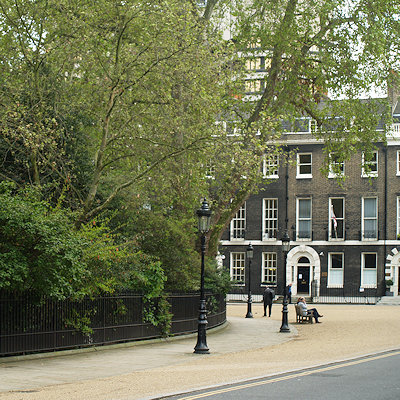
Like us on Facebook
PLACE NAMES


 
|
|
Bloomsbury
|

| |
The earliest record of what would become Bloomsbury is in the 1086 Domesday Book, which states that the area had vineyards and "wood for 100 pigs". But it is not until 1201 that the name Bloomsbury is first noted, when William de Blemond, a Norman landowner, acquired the land. The name Bloomsbury is a development from Blemondisberi - the bury, or manor, of Blemond.
At the end of the 14th century, Edward III acquired Blemond's manor, and passed it on to the Carthusian monks of the London Charterhouse, who kept the area mostly rural.
In the 16th century with the Dissolution of the Monasteries, Henry VIII took the land back into the possession of the Crown and granted it to Thomas Wriothesley, 1st Earl of Southampton.
In the early 1660s, the Earl of Southampton constructed what eventually became Bloomsbury Square. The Yorkshire Grey public house on the corner of Gray's Inn Road and Theobald's Road dates from 1676. The area was laid out mainly in the 18th century, largely by landowners such as Wriothesley Russell, 3rd Duke of Bedford, who built Bloomsbury Market, which opened in 1730. The major development of the squares that we see today started in about 1800 when Francis Russell, 5th Duke of Bedford removed Bedford House and developed the land to the north with Russell Square as its centrepiece.
Bloomsbury contains some of London's finest parks and buildings, and is particularly known for its formal squares. These include:
- Russell Square, a large and orderly square; its gardens were originally designed by Humphry Repton. The square is a short distance from Russell Square tube station.
- Bedford Square, built between 1775 and 1783, is still surrounded by Georgian town houses.
- Bloomsbury Square has a small circular garden surrounded by Georgian buildings.
- Queen Square, home to the National Hospital for Neurology and Neurosurgery.
- Gordon Square, surrounded by the history and archaeology departments of University College London, as well as the former home of John Maynard Keynes, the economist. This is where the Bloomsbury Group lived and met.
- Woburn Square and Torrington Square, home to other parts of University College London.
- Tavistock Square, home to the British Medical Association; its eastern edge was the site of one of the 7 July 2005 London bombings.
- Mecklenburgh Square, east of Coram's Fields, one of the few squares which remains locked for the use of local residents.
- Coram's Fields, a large recreational space on the eastern edge of the area, formerly home to the Foundling Hospital. It is only open to children and to adults accompanying children.
- Brunswick Square, now occupied by the School of Pharmacy and the Foundling Museum.
Historically, Bloomsbury is associated with the arts, education, and medicine. The area gives its name to the Bloomsbury Group of artists, the most famous of whom was Virginia Woolf, who met in private homes in the area in the early 1900s, and to the lesser known Bloomsbury Gang of Whigs formed in 1765 by John Russell, 4th Duke of Bedford. The publisher Faber & Faber used to be located in Queen Square, though at the time T S Eliot was editor the offices were in Tavistock Square. The Pre-Raphaelite Brotherhood was founded in John Millais's parents' house on Gower Street in 1848.
The Bloomsbury Festival was launched in 2006 when local resident Roma Backhouse was commissioned to mark the re-opening of the Brunswick Centre, a residential and shopping area. The free festival is a celebration of the local area, partnering with galleries, libraries and museums, and achieved charitable status at the end of 2012. As of 2013, the Duchess of Bedford is a festival patron and Cathy Mager is the Festival Director.
|
 Feel free to Email me any additions or corrections Feel free to Email me any additions or corrections
LINKS AVAILABLE TO YOUR SITE
| |





